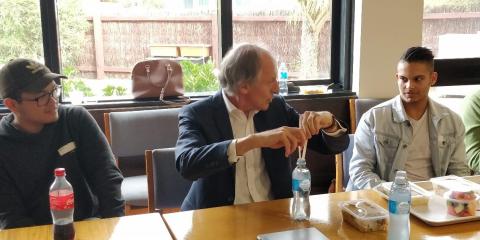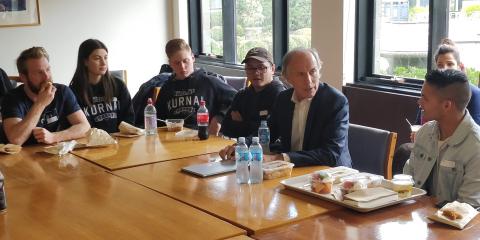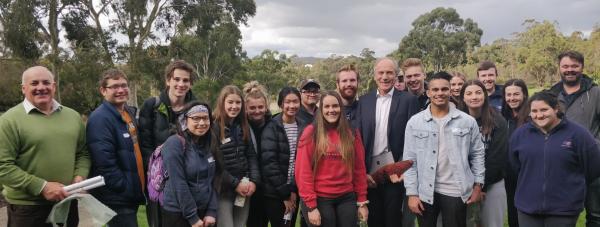An electrolysis demo using a bottle of water and two wooden forks?
What can you teach a group of students armed only with a bottle of water and two wooden forks?
How electrolysis works, of course … and then, how to make hydrogen (and capture it) by splitting the two atoms that make up water, oxygen and hydrogen.
A group of high school students from Kurnai College in Victoria’s LaTrobe Valley learned the answer to this question as Australia’s Chief Scientist, Dr Alan Finkel performed an impromptu demonstration on a visit to the school last month.
Taking a break from an industry and community seminar on the potential of hydrogen production at Federation University, Dr Finkel stopped by for lunch with about 20 senior students, when the question arose: how do you make hydrogen gas on earth, as it doesn’t exist in a pure form?
That’s when the water bottle and the forks made an appearance. Using these simple props, Dr Finkel explained that it is possible to make hydrogen by running an electric current through water, breaking open the hydrogen and water atoms, capturing the hydrogen, and releasing the water. “The captured hydrogen can then be transported,” he said, “to where it can be used in a range of applications, especially for long-haul transport fuel and in manufacturing.”
The students also spoke about a range of other topics including quantum computing and which subjects they should study in high-school to ensure they have options later on.
“I encourage you all to continue to study maths, English and science at the highest possible levels. These subjects are foundation subjects – you may not know yet what you want to do when you finish school, but these subjects will keep your options open and allow you to have a greater choice. I didn’t study neuroscience at high school, nor did I study how to be an entrepreneur, but the subject choices I made in high school (including maths, English and science) allowed me to pursue these career options later.”
College Principal Anthony Rodaughan spoke about the positive impact a visit such as this has on students at regional schools. “The students were just thrilled to have the chance to meet the Chief Scientist, and it’s great to show them what is possible to do when you study science and maths – it’s an exciting area to study and work in, particularly with emerging technologies.”



